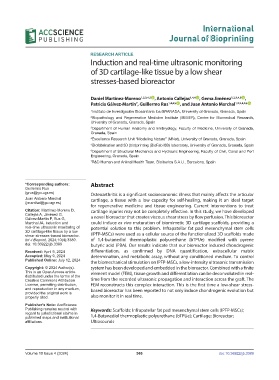Page 374 - IJB-10-4
P. 374
International
Journal of Bioprinting
RESEARCH ARTICLE
Induction and real-time ultrasonic monitoring
of 3D cartilage-like tissue by a low shear
stresses-based bioreactor
Daniel Martínez-Moreno 1,2,3,4,5 id , Antonio Callejas 1,4,6 id , Gema Jiménez 1,2,3,4,5 id ,
* , and Juan Antonio Marchal
*
Patricia Gálvez-Martín , Guillermo Rus 1,4,6 id 1,2,3,4,5 id
7
1 Instituto de Investigación Biosanitaria ibs.GRANADA, University of Granada, Granada, Spain
2 Biopathology and Regenerative Medicine Institute (IBIMER), Centre for Biomedical Research,
University of Granada, Granada, Spain
3 Department of Human Anatomy and Embryology, Faculty of Medicine, University of Granada,
Granada, Spain
4 Excellence Research Unit “Modeling Nature” (MNat), University of Granada, Granada, Spain
5 Biofabrication and 3D (bio)printing (BioFab i3D) laboratory, University of Granada, Granada, Spain
6 Department of Structural Mechanics and Hydraulic Engineering, Faculty of Civil, Canal and Port
Engineering, Granada, Spain
7
R&D Human and Animal Health Team, Bioiberica S.A.U., Barcelona, Spain
*Corresponding authors: Abstract
Guillermo Rus
(grus@go.ugr.es) Osteoarthritis is a significant socioeconomic illness that mainly affects the articular
Juan Antonio Marchal cartilage, a tissue with a low capacity for self-healing, making it an ideal target
(jmarchal@go.ugr.es)
for regenerative medicine and tissue engineering. Current interventions to treat
Citation: Martínez-Moreno D, cartilage injuries may not be completely effective. In this study, we have developed
Callejas A, Jiménez G,
Gálvez-Martín P, Rus G, a novel bioreactor that creates viscous shear stress by flow perfusion. This bioreactor
Marchal JA. Induction and could induce ex vivo maturation of biomimetic 3D cartilage scaffolds, providing a
real-time ultrasonic monitoring of potential solution to this problem. Infrapatellar fat pad mesenchymal stem cells
3D cartilage-like tissue by a low
shear stresses-based bioreactor. (IPFP-MSCs) were used as a cellular source of the functionalized 3D scaffolds made
Int J Bioprint. 2024;10(4):3389. of 1,4-butanediol thermoplastic polyurethane (bTPUe) modified with pyrene
doi: 10.36922/ijb.3389 butyric acid (PBA). Our results indicate that our bioreactor induced chondrogenic
Received: April 9, 2024 differentiation, as confirmed by DNA quantification, extracellular matrix
Accepted: May 9, 2024 determination, and metabolic assay, without any conditioned medium. To control
Published Online: July 12, 2024 the biomechanical stimulation on IPFP-MSCs, a low-intensity ultrasonic transmission
Copyright: © 2024 Author(s). system has been developed and embedded in the bioreactor. Combined with a finite
This is an Open Access article element model (FEM), tissue growth and differentiation can be deconvoluted in real-
distributed under the terms of the
Creative Commons Attribution time from the recorded ultrasonic propagation and interaction across the graft. The
License, permitting distribution, FEM reconstructs this complex interaction. This is the first time a low-shear stress-
and reproduction in any medium, based bioreactor has been reported to not only induce chondrogenic evolution but
provided the original work is
properly cited. also monitor it in real time.
Publisher’s Note: AccScience
Publishing remains neutral with Keywords: Scaffolds; Infrapatellar fat pad mesenchymal stem cells (IPFP-MSCs);
regard to jurisdictional claims in
published maps and institutional 1,4-Butanediol thermoplastic polyurethane (bTPUe); Cartilage; Bioreactor;
affiliations. Ultrasounds
Volume 10 Issue 4 (2024) 366 doi: 10.36922/ijb.3389

